Latest News
January 1, 2014
By Anthony J. Lockwood
Auto racing R&D never stops. From each physical experience, you learn something that will help you improve your design for the next season, and the seasons after that. Deadlines are tight. You need to go with a design straight to a physical event. And that means your simulations must be as fast, accurate and true to your target as possible.
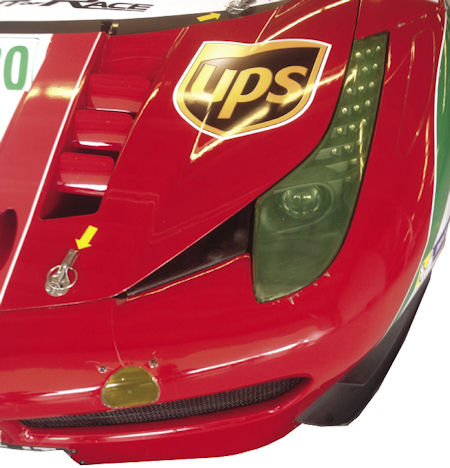 |
I recently had a chat with two engineers from the Italian racing team AF Corse, a Ferrari Corse Clienti (client racing) partner. These guys work on improving the durability of Ferrari’s GT racecars. Simulation serves a vital role in their efforts. Or, as one of the engineers put it, they simulate the car’s systems as much as possible because it gives them the power to act on a problem immediately.
Performance for Endurance
GT, from the Italian meaning gran turismo (grand tourer), racecars are performance or luxury cars, usually coupes. They’re tweaked to be very fast, and are able to maintain their performance over long distances. I met the AF Corse engineers in the paddock at Circuit of The Americas in Austin, TX, during a break in their preparations for the fifth round of the Fédération Internationale de l’Automobile World Endurance Championship (FIA WEC) championship series. Austin was the U.S. stop in this series of 6-hour endurance races, held worldwide.
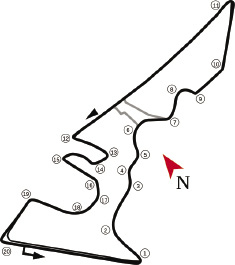 The track at Circuit of The Americas has some nasty curves. Image created by Francesco Betti Sorbelli and courtesy of Creative Commons. |
Circuit of The Americas is a new, multipurpose race complex that can handle all classes of racing, including the Formula 1 United States Grand Prix. It is the first purpose-built Grand Prix facility in the U.S. Its 3.4-mile circuit track has four straightaways, 20 curves, and a 133-ft. elevation change.
Ferrari uses a variety of ANSYS computational fluid dynamics (CFD) and finite element analysis (FEA) tools for jobs ranging from suspension systems to brake cooling systems and full-body dynamics. Ferrari doesn’t talk much about how it uses ANSYS software, since they consider it to be a strategic tool used for proprietary work. It was, however, mentioned during the course of our conversation that ANSYS FEA helped engineers optimize a part in Ferrari’s rear suspension system. The part had been cracking in less than 6,000 km of use. With its new ANSYS optimization, the part has now been running for more than 10,000 km—with no sign of cracking yet.
AF Corse uses ANSYS to fine-tune the designs it gets from Ferrari. Three key assignments and one key need of ANSYS CFD were the subjects of our discussion:
1. Predict the down force on the car to ensure it will stick on the road when negotiating curves at racing speeds.
2. Design and optimize the brake cooling system.
3. Optimize the design of the side mirrors.
4. Do it quickly.
Going with the Flow
The brake cooling and side mirror design optimization jobs are tightly related, almost inseparable. Both projects had been ongoing for 10 years, according to the AF Corse engineers.
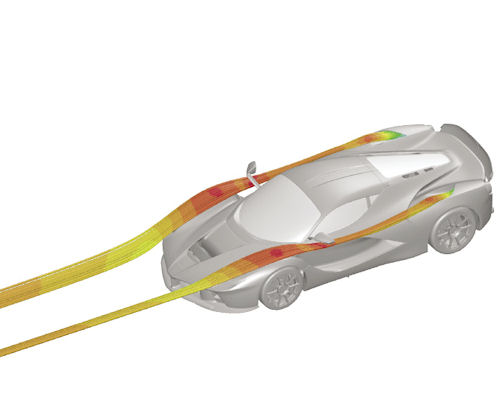 Pathlines show the predicted airflow around the Ferrari’s side-view mirrors being directed into the rear brake cooling system. Image courtesy of ANSYS Corp. |
The brake cooling system assembly is a highly complex device. It consists of a pair of parallel air intakes and outtakes, front and rear, on both sides of the car. The basic idea is to scoop air from the outside, funnel it around the brakes for cooling, and direct it out and away from the car—all without interfering with the downward force or messing up the aerodynamic flows around the car.
This sounds simple enough, if you don’t have to design it. Now add in the complication that the Ferrari has a rear-mounted engine. As originally designed, the airflow around the side-view mirrors interfered with engine cooling and misshaped the car’s aerodynamic form.
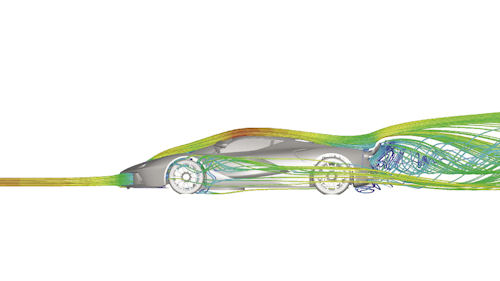 An ANSYS simulation of the airflow around the left side of the Ferrari 458 Italia #51 GT racecar. Image courtesy of ANSYS Corp. |
Using ANSYS CFD software, AF Corse engineers were able to optimize the car’s side-view mirrors so that they maintained the car’s aerodynamic form without disturbing the airflow supplying the rear engine, yet still feeding diverted air into the rear brake cooling inlets.
But that was even less simple than it sounds.
The brake cooling system job, coupled with the side-view mirror redesign and analysis, turned out to be a vast, computationally intensive multiphysics (MP) analysis undertaking. The key to turning the page on this 10-year-old project was that ANSYS CFD solutions such as Fluent, as well as other ANSYS software, are inherently high-performance computing (HPC)-ready.
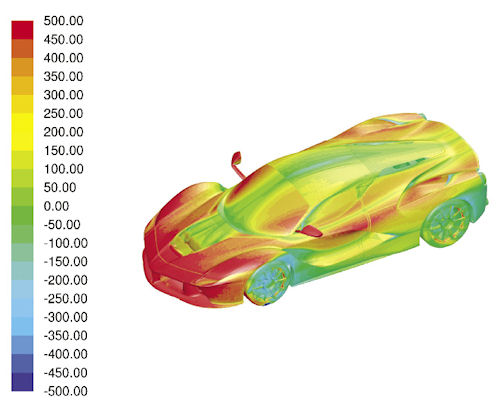 A view of the total surface pressure. Image courtesy of ANSYS Corp. |
HPC provided the engineers with the raw horsepower they needed to fully use ANSYS, and parallel processing to explore quickly and solve accurately hundreds of possible cooling system designs without comprising meshes or details. That meant that the engineers were able to analyze the front and rear brake cooling systems and the side-view mirrors, both as individual subsystems and as constituent components within the entire brake cooling assembly. The level of design detail they leveraged could not have been achieved with a typical engineering workstation and still earn the tag “quickly.”
Fast Collaborators
Ferrari has worked with ANSYS CFD and FEA solutions to optimize key components of its GT category racecars for more than 15 years. In that time, ANSYS has become an official Ferrari GT Championships Sponsor Partner. It’s a mutually beneficial relationship. Ferrari provides feedback and suggestions for functions they need, and ANSYS develops the code. Eventually, these new features and functions work their way to ANSYS users.
In a sense, the physical tests that validate all of the AF Corse simulations happen on the track. So, I asked one of the engineers how the ANSYS-Ferrari relationship was really working out for them. He responded that “the more you use these tools, the more you want to use them.”
The results make it obvious to see why: AF Corse Ferrari 458 Italia #51, already the champs in the FIA WEC (GTE Pro category) series, took the 2013 series lead in Austin—and went on to be the threepeat champs with a win in Bahrain in December.
Anthony J. Lockwood is Editor-at-Large for Desktop Engineering. He may be contacted via [email protected]. Editor’s note: ANSYS Corp. paid for Tony Lockwood’s hotel room in Austin for his meeting with AF Corse engineers. Desktop Engineering covered all other expenses. No additional considerations were offered by ANSYS, and ANSYS did not attempt to influence the content of this article.
More Info
Subscribe to our FREE magazine, FREE email newsletters or both!
Latest News
About the Author
Anthony J. Lockwood is Digital Engineering’s founding editor. He is now retired. Contact him via [email protected].
Follow DE





